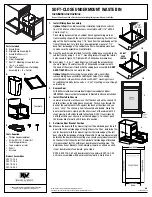
1.2.4 Travel on public roads
WARNING: Environmental transportation hazard.
Personal injury or chemical spill can occur.
A loaded machine driven on public roads has a high risk of tire failure. Do not use the
machine for transporting product on public roads.
Always walk around and visually inspect the machine before traveling on public roads. As a warning, honk
the horn twice before starting the engine. Check for damage and or faulty components that can fail and
create a hazardous condition. Make sure all machine systems operate properly including, but not limited to,
front road lights, tail and brake lights, hazard warning lights, park brake, horn, windscreen wiper and
washer, and rear view mirrors. Repair or replace any component not in proper working order.
Never drive at a speed causing the machine to bounce or lose control.
Obey all traffic laws. Operate the machine with hazard warning lights or rotating beacon / strobe beacon, if
equipped, on, unless prohibited by law. The use of road lights while traveling on public roads is the
operator's responsibility.
1.2.5 Stop and park
Machine overturns, collisions, runaways, and crushing accidents can occur when an operator ignores safety
procedures.
Failure to signal before you stop, you turn or you slow on public roads, or anywhere can cause a possible
risk.
Pull to the side of the road before you stop.
Be very careful when you stop on slippery surfaces or with heavy loads.
Always engage the parking brake when the machine has stopped.
Remove the key to prevent any personnel not approved from operating the machine.
1.2.6 Overhead Electrical Power Lines
Never let the machine come into contact with
overhead power lines. The radio antenna must be
bent over and secured in place any time overhead
electrical power lines are near the machine. This
can decrease the possibility that the machine may
come into contact with an overhead power line
when in operation or when the machine is
transported.
GUID-7EC381DD-7EAC-4CC9-8211-9993FD2D867C-high.jpg [High]
Fig. 11
1.2.7 Avoid Eye Contact with Radar
Radar ground sensors emit a low intensity
microwave signal. The microwave signal will not
cause any ill effects during normal use. Although
the intensity is low, to avoid eye damage, never
look directly into the sensor while the sensor is in
operation.
GUID-11A2F16B-F74A-40CA-AA12-04E51A0AB69D-high.jpg [High]
Fig. 12
GUID-1297D337-508B-4FA7-88ED-BCB0577A38E5 [V5]
GUID-6D57EACC-87C0-486A-A753-AC474AE0AF05 [V4]
GUID-7E4E2EA3-6FD9-4C5B-992A-14695F41F577 [V1]
GUID-4B8E0B85-0729-4BD2-82D3-C0FC9032F049 [V2]
1. Safety
Application System
15
609146D1A
Содержание New Leader NL4330G4
Страница 6: ...Table of contents Application System 609146D1A Find manuals at https best manuals com...
Страница 8: ...Table of contents 8 Application System 609146D1A Find manuals at https best manuals com...
Страница 21: ...This as a preview PDF file from best manuals com Download full PDF manual at best manuals com...







































